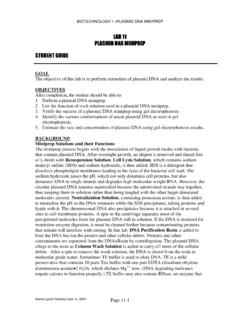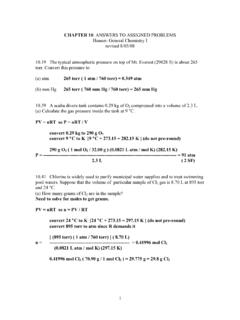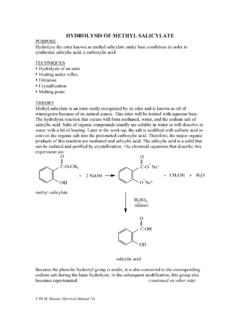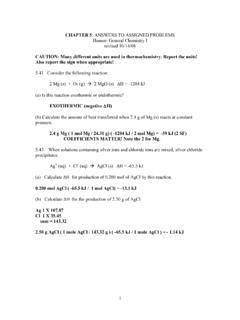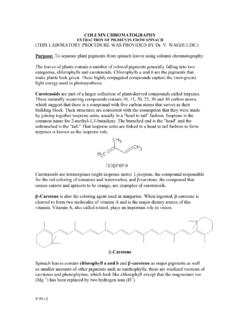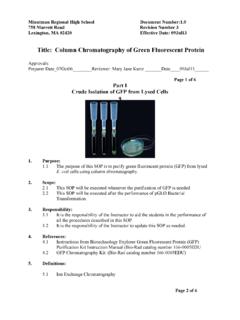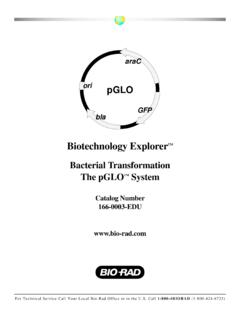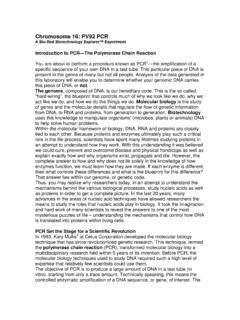Transcription of PAGE of Proteins - Users' Server
1 biotechnology I PAGE DETERMINATION OF protein FINGERPRINTS Written by Eilene Lyons Revised 1/12/2010 Page 3-1 LAB 3 PAGE DETERMINATION OF protein FINGERPRINTS STUDENT GUIDE Information from an NSF sponsored workshop was used in adapting this lab: Genomics: from Mendel to Microchips, taught by the Partnership for Plant Genomics Education at the University of California Davis, July 2005. The lab was originally adapted from biotechnology explorer protein Fingerprinting Instruction Manual Bio-Rad DNA Fingerprinting Partnership for Research and Education in Plants. GOAL The goal of this lab is to separate Proteins by polyacrylamide gel electrophoresis and to analyze the data using a standard curve graphed using MS Excel.
2 OBJECTIVES After completion, the student should be able to 1. Perform a common type of plant protein extraction 2. Perform the technique of SDS-PAGE. 3. State the purpose for SDS-PAGE in the research laboratory. 4. Explain how Proteins will move through SDS polyacrylamide gels when placed in an electric field. 5. Explain the need for denaturation and reduction when separating Proteins by size. 6. Estimate the molecular weight of a protein using Proteins of known molecular weights as standards. 7. Analyze electrophoresis data using manual and Excel graphing. TIMELINE This lab will take 2 laboratory periods: DAY 1: Prep for the lab, extract plant Proteins , run SDS PAGE, stain and destain DAY 2: Graph results using MS Excel and analyze BACKGROUND Proteomics is the study of the complete set of Proteins present in an organism.
3 The number of Proteins in an organism far exceeds the number of genes, which is due in part to molecular mechanisms of gene control. These processes include shuffling of DNA to form different genes (such as that seen in antibody production), post transcriptional control, and post translational control of protein production. Proteomics is a growing field that employs sophisticated molecular techniques such as two dimensional gel electrophoresis and mass spectrometry. Understanding the basis of protein separation by polyacrylamide gel electrophoresis is the first step in understanding proteomics.
4 Electrophoresis is a technique that separates charged molecules in an electric field. Negatively charged molecules migrate in an electric field toward the anode; positively charged molecules move toward the cathode. In polyacrylamide gel electrophoresis (PAGE), molecules move through a porous gel matrix that separates molecules on the basis of both charge and size. This migration is complicated because both the size (mass) and the net charge of the molecule contribute to the migration. Proteins can have different biotechnology I PAGE DETERMINATION OF protein FINGERPRINTS Written by Eilene Lyons Revised 1/12/2010 Page 3-2 charges because the side chains of many amino acids carry a charge.
5 Proteins move through the gel based on their charge to mass ratio. That is, the higher the negative charge, the faster the protein migrates; conversely, the larger the size, the slower the protein migrates. The separation of Proteins in polyacrylamide gels on the basis of their charge to mass ratio is called non-denaturing or native gel electrophoresis. This technique is most commonly used when the native conformation and activity of the protein must be maintained. Many Proteins of different sizes have similar charge to mass ratios; these Proteins would migrate very similarly in a polyacrylamide gel, and therefore would not be resolved.
6 Another problem with native gel electrophoresis is that many Proteins consist of multiple subunits that make the molecule too large to separate easily by polyacrylamide gel electrophoresis. These problems can be overcome by another technique called denaturing gel electrophoresis, or SDS polyacrylamide gel electrophoresis (SDS-PAGE). In this technique, Proteins are treated with a strong anionic (negatively charged) detergent called sodium dodecyl sulfate (SDS) that binds to Proteins in proportion to the size (mass) of the protein (about one molecule of SDS per amino acid). That is, a protein of 20 kD would bind twice as much SDS as a protein of 10 kD.
7 In addition to the influence of mass on protein movement through polyacrylamide, protein shape can also affect the migration rate. To separate two Proteins strictly on the basis of size, they must also have the same shape. When protein samples are denatured by heating and treatment with reducing agents such as -mercaptoethanol (that break disulfide bonds between two cysteine amino acids), the polypeptides that make up the protein separate, unfold, bind SDS and assume a rod-like structure. Since the length of these rod-like molecules is proportional to the size of the polypeptide, denatured SDS polypeptides migrate in polyacrylamide gels primarily on the basis of size.
8 Proteins separated by SDS-PAGE can be compared to denatured polypeptides of known size to determine their mass. Polyacrylamide is a synthetic polymer or chain of acrylamide monomers. These acrylamide chains can be crosslinked to each other by the addition of bisacrylamide during the polymerization reaction. The bisacrylamide crosslinks cause the chains to form a mesh-like structure, in which the holes of the mesh represent the pores that retard protein migration in the gel. At higher acrylamide or bisacrylamide concentrations, the mesh becomes tighter with smaller pores that more strongly retard the migration of Proteins .
9 Proteins can be separated on polyacrylamide gels of a consistent concentration determined by the sizes of the Proteins to be separated. Large Proteins require a lower concentration of acrylamide in the gel. Acrylamide concentrations in the range of 10% to 15% separate Proteins of about 12,000 to 70,000 daltons. In many instances, separation of Proteins can be improved by the addition of another layer of acrylamide of a different pH atop the separating gel. This top layer, called a stacking gel, has large pores that allow rapid migration of the Proteins until they reach the boundary where the separating gel begins.
10 The protein migration abruptly slows, and the Proteins stack, so that they enter as a thin zone at the surface of the separating gel. The pH and concentration differences between the two gels result in well defined, narrow protein bands that are better resolved making analysis easier. A gradient gel is used to separate Proteins of widely different sizes while also separating those of similar sizes. The highest concentration, which biotechnology I PAGE DETERMINATION OF protein FINGERPRINTS Written by Eilene Lyons Revised 1/12/2010 Page 3-3 retards small Proteins , is at the bottom of the gel and the lowest concentration, for larger Proteins , is near the top.
